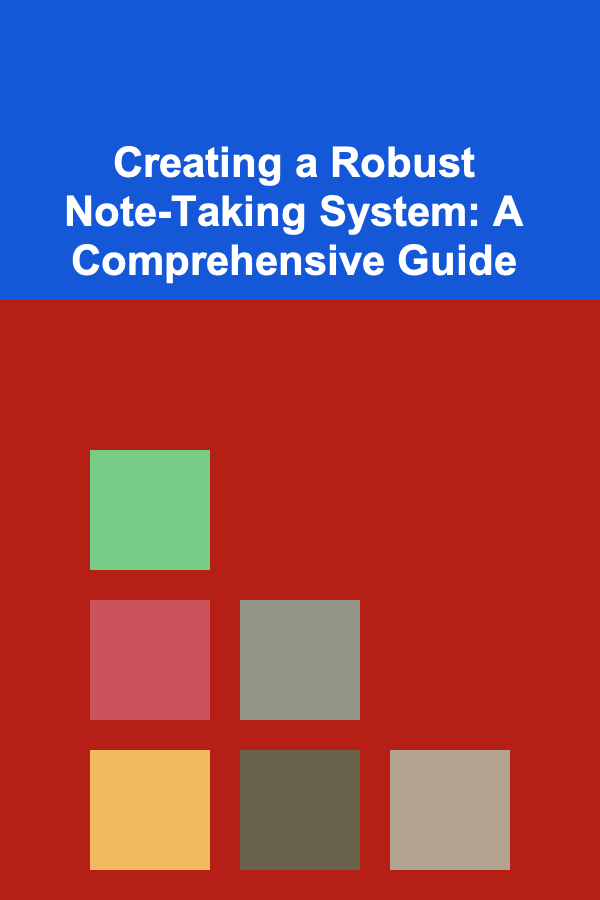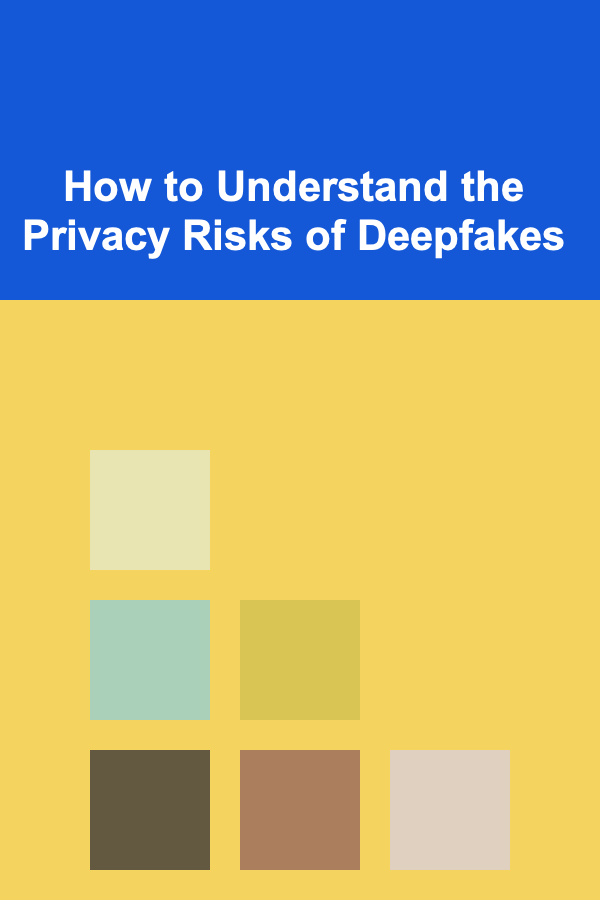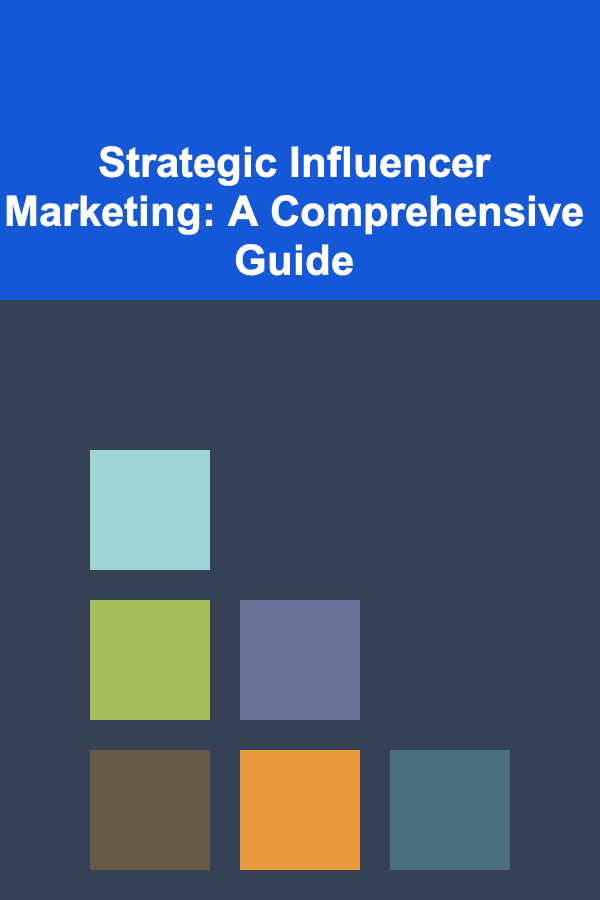
Creating a Robust Note-Taking System: A Comprehensive Guide
ebook include PDF & Audio bundle (Micro Guide)
$12.99$11.99
Limited Time Offer! Order within the next:

In the age of information overload, having a reliable and efficient note-taking system is no longer a luxury, but a necessity. Whether you're a student, researcher, writer, or simply someone who wants to capture and organize ideas effectively, a well-designed note-taking system can significantly enhance your learning, productivity, and creativity. This comprehensive guide delves into the principles, strategies, and tools involved in creating a note-taking system that works for you. We'll explore various methods, discuss the importance of consistency and review, and offer practical tips for optimizing your note-taking process.
Understanding the Purpose of Note-Taking
Before diving into the specifics, it's crucial to understand the underlying purpose of note-taking. Note-taking isn't simply about transcribing information; it's about actively engaging with the material, understanding its key concepts, and creating a personal record that you can later refer to. The primary goals of note-taking include:
- Capturing Information: Recording the essential details from lectures, readings, meetings, or other sources.
- Understanding Concepts: Processing and interpreting the information in your own words, fostering deeper comprehension.
- Organizing Thoughts: Structuring and categorizing information to make it easily accessible and retrievable.
- Reviewing and Remembering: Creating a resource that allows you to review and reinforce your learning.
- Generating Ideas: Using notes as a springboard for further thought, analysis, and creative endeavors.
Recognizing these goals will help you tailor your note-taking approach to maximize its effectiveness.
Choosing the Right Note-Taking Method
There are numerous note-taking methods to choose from, each with its own strengths and weaknesses. The best method for you will depend on your learning style, the type of information you're dealing with, and your personal preferences. Here are some of the most popular and effective methods:
1. The Cornell Method
The Cornell Method is a structured approach that divides your note page into three sections:
- Notes Column (Right): This is the largest section where you take notes during the lecture or reading. Focus on capturing the main ideas, key details, and supporting information. Use abbreviations, symbols, and shorthand to speed up the process.
- Cue Column (Left): After the lecture or reading, review your notes and write keywords, questions, or prompts in this column. These cues should help you recall the main ideas and test your understanding.
- Summary Section (Bottom): At the end of the page, write a brief summary of the entire page's content. This helps you consolidate your learning and provides a quick overview for future review.
Benefits: Organizes notes logically, encourages active recall, and provides a concise summary for review.
Best For: Lectures, presentations, and readings where you need to capture and understand a large amount of information.
2. Linear Note-Taking
Linear note-taking is the simplest and most common method. It involves writing notes sequentially in a linear fashion, typically from top to bottom. You can use headings, subheadings, and bullet points to organize the information.
Benefits: Easy to implement, requires minimal preparation, and suitable for various types of information.
Best For: Situations where you need to quickly capture information without a structured format, such as brainstorming sessions or informal meetings.
3. Outlining Method
The outlining method uses a hierarchical structure to organize information. Main topics are represented by Roman numerals, subtopics by capital letters, and further details by numbers and lowercase letters.
Example:
I. Main Topic
A. Subtopic
1. Detail
2. Detail
B. Subtopic
II. Main Topic
A. Subtopic
Benefits: Clearly shows the relationships between ideas, facilitates logical organization, and helps you identify gaps in your understanding.
Best For: Lectures or readings that are already structured in a hierarchical manner, such as textbooks or formal presentations.
4. Mind Mapping
Mind mapping is a visual note-taking technique that uses a central idea or concept as the starting point. Related ideas and information are then branched out from the central idea, creating a visual representation of the connections between different concepts.
Benefits: Encourages creative thinking, helps you see the big picture, and makes it easy to identify relationships between ideas.
Best For: Brainstorming, generating ideas, and understanding complex topics with multiple interconnected concepts.
5. Sketchnoting
Sketchnoting combines visual elements with text to create engaging and memorable notes. It involves using drawings, doodles, symbols, and hand-lettering to represent information.
Benefits: Enhances visual memory, makes notes more engaging, and helps you process information in a creative way.
Best For: Visual learners, creative individuals, and situations where you want to make your notes more memorable and engaging.
6. The Zettelkasten Method (Slip-Box)
The Zettelkasten method, popularized by sociologist Niklas Luhmann, is a system for building a network of interconnected ideas. Each idea is written on a separate "slip" (or note card) and assigned a unique identifier. Notes are then linked together based on their relationships, creating a web of knowledge.
Benefits: Fosters deep understanding, encourages creative thinking, and allows you to connect ideas in unexpected ways.
Best For: Long-term research projects, writing, and building a personal knowledge base.
Choosing the right method is a personal decision. Experiment with different methods to find the one that best suits your needs and preferences.
Digital vs. Analog Note-Taking
Another crucial decision is whether to take notes digitally or using traditional pen and paper. Both approaches have their advantages and disadvantages.
Digital Note-Taking
Pros:
- Organization: Digital notes can be easily organized, tagged, and searched.
- Accessibility: You can access your notes from anywhere with an internet connection.
- Flexibility: You can easily edit, rearrange, and add to your notes.
- Multimedia: You can embed images, audio, and video into your notes.
- Collaboration: You can easily share your notes with others.
Cons:
- Distractions: Digital devices can be distracting due to notifications and other apps.
- Technical Issues: You may experience technical problems such as software crashes or data loss.
- Cost: Digital note-taking often requires purchasing software or devices.
- Potential for Superficiality: The ease of copying and pasting can lead to passive note-taking without deep processing.
Popular Digital Note-Taking Tools:
- Evernote: A versatile note-taking app with features for organizing, tagging, and searching.
- OneNote: Microsoft's note-taking app, integrated with other Microsoft Office applications.
- Notion: A powerful workspace that combines note-taking, project management, and database features.
- Google Docs: A free and widely used word processor that can also be used for note-taking.
- Bear: A minimalist note-taking app for Mac and iOS.
- Obsidian: A powerful knowledge base that works on top of a local folder of plain text Markdown files. Emphasizes linking between notes to build a network of thoughts.
- Roam Research: A networked thought tool for organizing and evaluating knowledge. Similar to Obsidian, but cloud-based.
Analog Note-Taking
Pros:
- Focus: Less distractions, allowing you to focus on the task at hand.
- Tangible: The physical act of writing can improve memory and understanding.
- Creativity: Easier to draw diagrams, mind maps, and sketchnotes.
- Cost-Effective: Requires only pen and paper.
Cons:
- Organization: Can be difficult to organize and search through large volumes of handwritten notes.
- Accessibility: Notes are not easily accessible from different locations.
- Portability: Carrying around notebooks can be inconvenient.
- Durability: Handwritten notes can be easily damaged or lost.
Ultimately, the choice between digital and analog note-taking depends on your personal preferences and the specific requirements of your note-taking tasks. Many people find a hybrid approach to be the most effective, using digital tools for organization and accessibility while using pen and paper for brainstorming and creative thinking.
Key Principles for Effective Note-Taking
Regardless of the method you choose, there are several key principles that will help you take effective notes:
1. Active Listening/Reading
Note-taking is not a passive activity. Engage actively with the material by listening attentively, reading carefully, and thinking critically about the information being presented. Ask yourself questions like, "What is the main point?", "How does this relate to what I already know?", and "What are the implications of this information?".
2. Selective Note-Taking
Don't try to write down everything. Focus on capturing the most important information, such as main ideas, key details, and supporting examples. Use abbreviations, symbols, and shorthand to speed up the process.
3. Paraphrasing and Summarizing
Avoid simply copying information verbatim. Instead, paraphrase and summarize the information in your own words. This will help you understand the material more deeply and create a more personalized record.
4. Organizing Information Logically
Structure your notes in a logical and coherent manner. Use headings, subheadings, bullet points, and numbering to organize the information. This will make it easier to review and understand your notes later.
5. Visual Cues
Use visual cues, such as diagrams, mind maps, and sketchnotes, to represent information in a more engaging and memorable way. Visual cues can help you see the big picture and make connections between different concepts.
6. Consistent Formatting
Establish a consistent formatting style for your notes. Use the same headings, subheadings, and bullet points throughout your notes. This will make it easier to navigate and understand your notes later.
7. Use of Color
Strategically using color can greatly enhance recall and organization. Use different colors to highlight key concepts, differentiate between topics, or emphasize relationships. Avoid overusing color, as it can become distracting.
8. Leave Space
Don't cram your notes together. Leave plenty of space between lines and sections so you can easily add to your notes later. This also makes the notes less intimidating to review.
9. Abbreviation and Symbols
Develop a consistent system of abbreviations and symbols to speed up your note-taking. For example, you could use "e.g." for "for example," "i.e." for "that is," and arrows to indicate relationships between ideas. Just be sure your abbreviations are clear and consistent.
Creating a System for Note Management and Review
Taking notes is only half the battle. To truly benefit from your notes, you need to have a system for managing and reviewing them regularly.
1. Consistent Review Schedule
Set aside time each day or week to review your notes. This will help you reinforce your learning and identify any gaps in your understanding. The frequency of review depends on the subject matter and your personal learning style. Immediately after a lecture or reading is often the most valuable time to review.
2. Spaced Repetition
Use spaced repetition to review your notes at increasing intervals. This technique has been shown to be highly effective for long-term retention. Tools like Anki can be used to create flashcards and schedule reviews using spaced repetition algorithms.
3. Active Recall
Instead of passively reading your notes, actively try to recall the information from memory. Use the cue column in the Cornell Method or flashcards to test your knowledge. This active recall strengthens neural pathways and improves retention.
4. Note Organization
Organize your notes in a way that makes sense to you. Use folders, tags, and keywords to categorize your notes. Consider using a note-taking app with built-in organization features. In a physical notebook, consider assigning different notebooks to different subjects or projects.
5. Summarization and Synthesis
Periodically summarize your notes to consolidate your learning. Try to condense the main ideas into a few sentences or a mind map. This helps you see the big picture and make connections between different concepts. Also, try to synthesize information from different sources into a coherent whole. How do the ideas from one lecture relate to the ideas from a previous reading?
6. Connection and Linking
Connect your notes to each other by creating links between related ideas. This helps you build a network of knowledge and see the relationships between different concepts. Tools like Obsidian and Roam Research are specifically designed for this purpose.
7. Regular Purging
Be ruthless in purging old, irrelevant notes. Keeping only the essential information reduces clutter and makes it easier to find what you need. Don't be afraid to delete or archive notes that are no longer useful.
Adapting Your System Over Time
Your note-taking system should be a living document that evolves over time as your needs and preferences change. Be open to experimenting with different methods and tools, and don't be afraid to make adjustments to your system as needed.
1. Reflect on Your Note-Taking Process
Regularly reflect on your note-taking process. Ask yourself questions like: "What's working well?", "What could be improved?", and "What new methods or tools should I try?".
2. Seek Feedback
Ask for feedback from others on your note-taking system. Share your notes with classmates or colleagues and ask them for their opinions. Consider participating in online forums or communities dedicated to note-taking.
3. Stay Updated on New Tools and Techniques
The field of note-taking is constantly evolving with new tools and techniques emerging all the time. Stay updated on the latest developments by reading blogs, attending workshops, and experimenting with new apps and software.
4. Be Patient
Building an effective note-taking system takes time and effort. Don't get discouraged if you don't see results immediately. Keep experimenting, keep refining, and keep adapting your system until you find something that works for you.
Specific Note-Taking Strategies for Different Scenarios
The best note-taking approach can vary depending on the context. Here are some strategies for different scenarios:
Lectures
- Prepare in Advance: Review previous lecture notes or reading materials to familiarize yourself with the topic.
- Listen Actively: Focus on understanding the main points and key details.
- Ask Questions: Don't be afraid to ask questions to clarify anything you don't understand.
- Use Visual Cues: Draw diagrams or mind maps to represent complex concepts.
- Review Immediately: Review your notes as soon as possible after the lecture to reinforce your learning.
Readings
- Preview the Material: Skim the headings, subheadings, and introduction to get a sense of the overall structure.
- Read Actively: Highlight key passages and make notes in the margins.
- Summarize Each Section: After reading each section, summarize the main points in your own words.
- Connect to Existing Knowledge: Think about how the information relates to what you already know.
- Review and Synthesize: Review your notes and synthesize the information from different sources.
Meetings
- Come Prepared: Review the agenda and any relevant materials in advance.
- Focus on Action Items: Pay close attention to action items and deadlines.
- Clarify Ambiguities: Don't hesitate to ask questions to clarify any ambiguities.
- Record Key Decisions: Make sure to record all key decisions and outcomes.
- Distribute Notes: Share your notes with other attendees after the meeting.
Research
- Use a Citation Manager: Use a citation manager like Zotero or Mendeley to keep track of your sources.
- Take Detailed Notes: Record all relevant information, including quotes, paraphrases, and your own thoughts.
- Organize by Topic: Organize your notes by topic or theme.
- Synthesize Information: Synthesize the information from different sources to develop your own arguments and insights.
- Regularly Review and Refine: Regularly review and refine your notes as you continue your research.
Conclusion
Creating a robust note-taking system is an ongoing process that requires experimentation, adaptation, and a willingness to learn. By understanding the principles of effective note-taking, choosing the right methods and tools, and establishing a consistent system for management and review, you can transform your notes from a mere collection of information into a powerful tool for learning, productivity, and creative thinking. Remember that there's no one-size-fits-all solution; the best system is the one that works best for you. Embrace the journey of discovery and continuously refine your system to meet your evolving needs.

How to Build an Evening Routine Checklist for Better Sleep
Read More
How to Install Window Security Bars Without Ruining Aesthetics
Read More
How to Use Folding Techniques for Neat Clothing Storage
Read More
What Inspirational Stories Can Motivate You to Organize Your Home?
Read More
How to Understand the Privacy Risks of Deepfakes
Read More
Strategic Influencer Marketing: A Comprehensive Guide
Read MoreOther Products

How to Build an Evening Routine Checklist for Better Sleep
Read More
How to Install Window Security Bars Without Ruining Aesthetics
Read More
How to Use Folding Techniques for Neat Clothing Storage
Read More
What Inspirational Stories Can Motivate You to Organize Your Home?
Read More
How to Understand the Privacy Risks of Deepfakes
Read More